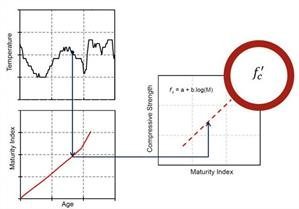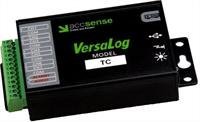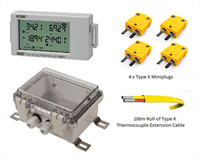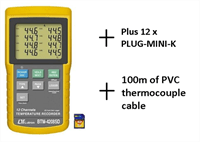Thermocouple Data Logging to determine Concrete Maturity
Thermocouple Data Logging to determine Concrete Maturity |
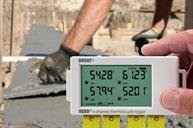 | Concrete maturity is a measure of what proportion of freshly poured concrete has cured. It is a quick reference of the in-place strength at that particular point in time, relative to the ultimate strength when the slab has fully cured. Traditional methods are often time consuming and are much more in depth, they typically require compression tests such as made in a lab on field cured sample cylinders of concrete made during the pour or pullout or penetration tests made on site. | ||||
The maturity method calculates an index based on time-temperature data which provides a relative indicator of strength.
This particular method is very attractive because it can be done quickly onsite at a relatively low price point with a thermocouple
data logger and sensors impeded in the pour.
What is concrete maturity?
The maturity method is a convenient approach to predict the early age strength gain of concrete, using the principle that the concrete strength is directly related to the hydration temperature history of cementitious paste. This method can potentially address many immediate challenges facing the concrete industry such as predicting appropriate time for formwork stripping and post-tensioning, especially at low temperatures while the strength development of concrete is hindered; and optimizing concrete mix design and concrete curing conditions (e.g. concrete heating at low temperatures or surface protection in hot-dry weathers). The (ASTM) has created a standard procedure for estimating concrete strength using the maturing method, ASTM standard C 1074. This
method requires an initial calibration process which requires an evaluation of the maturity index in parallel with more traditional
compressive strength test to develop the maturity index vs. strength curve. Once this curve is established it is assumed to
be valid for any pours that use the same mix recipe.
The maturity index is calculated from the raw time temperature data using one of 2 expressions:
1. The temperature-time factor:
Where: M(t)= Maturity temperature-time factor
Ta = Average temperature during a time interval
To = Datum temperature below which no hydration occurs
Δt = time interval between measurements
2. Equivalent age using an Arrhenius function:
Where:
te = Equivalent age
Q = Activation energy divided by gas constant K
Ta = Average temperature during the time interval
Ts = Datum temperature below which no hydration occurs
Δt = time interval between measurements
Of these 2 methods, the second is more accurate, but the first is considered sufficient for most applications. What do you need to perform this testing? The ability to perform the maturity method in real applications requires 3 components. The first is temperature sensors, these
need to be embedded in the pour. This can be accomplished using a roll of thermocouple extension cable. We commonly supply
the IC-KX-7/0.2PVC-100 which is a 100m roll single-pair, thermocouple extension and compensating cable with laid flat construction.
To create the sensor you strip back a small section of the end of the wire, approximately 10mm, you then twist the two conductors
together. The sensors are then placed in a convenient location in the pour ensuring good physical contact is made with the
concrete. The thermocouple wire is then extended to a location where the logger can be housed out of harm’s way.
You then need a data logger to connect these sensors to. In general you will want to do a few points, as such a 4, 8 or 12 channel logger will be best suited. For the 4 channel unit we recommend the HOBO UX120-014M with the weatherproof case, we offer it in a kit with cable and miniplugs so you have the full kit. For the 8 channel option the Versalog-TC is well suited and then for the 12 channel option we offer the ICBTM4208SD in a full kit with Thermocouple Cable and miniplugs.
The last thing you will require is a piece of software to analyse and calculate the Maturity time-temperature factor or equivalent age. The equations above can be quickly created in Microsoft Excel. All of the previously mentioned data loggers allow recorded data to be exported as a .CSV text file that can be easily imported into Excel. For more information on concrete temperature monitoring, or to find the ideal solution for your specific needs, contact one of
our Scientists on 1300 737 871 or email them at
[email protected] | |||||
Contact our expert scientists now to get the right meter or data logger to suit your needs and discuss your project.
Phone: 1300 737 871
Email: [email protected]

